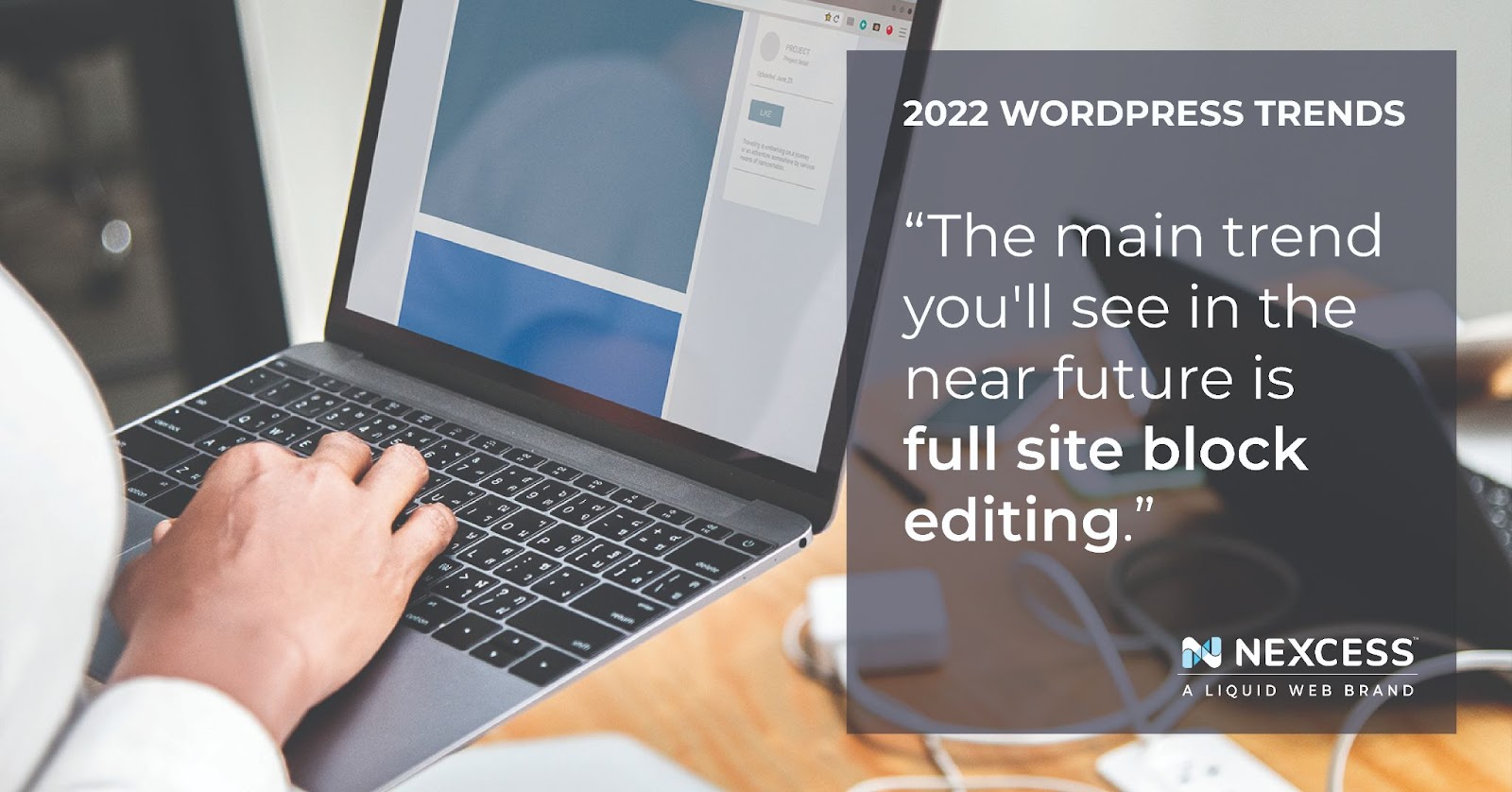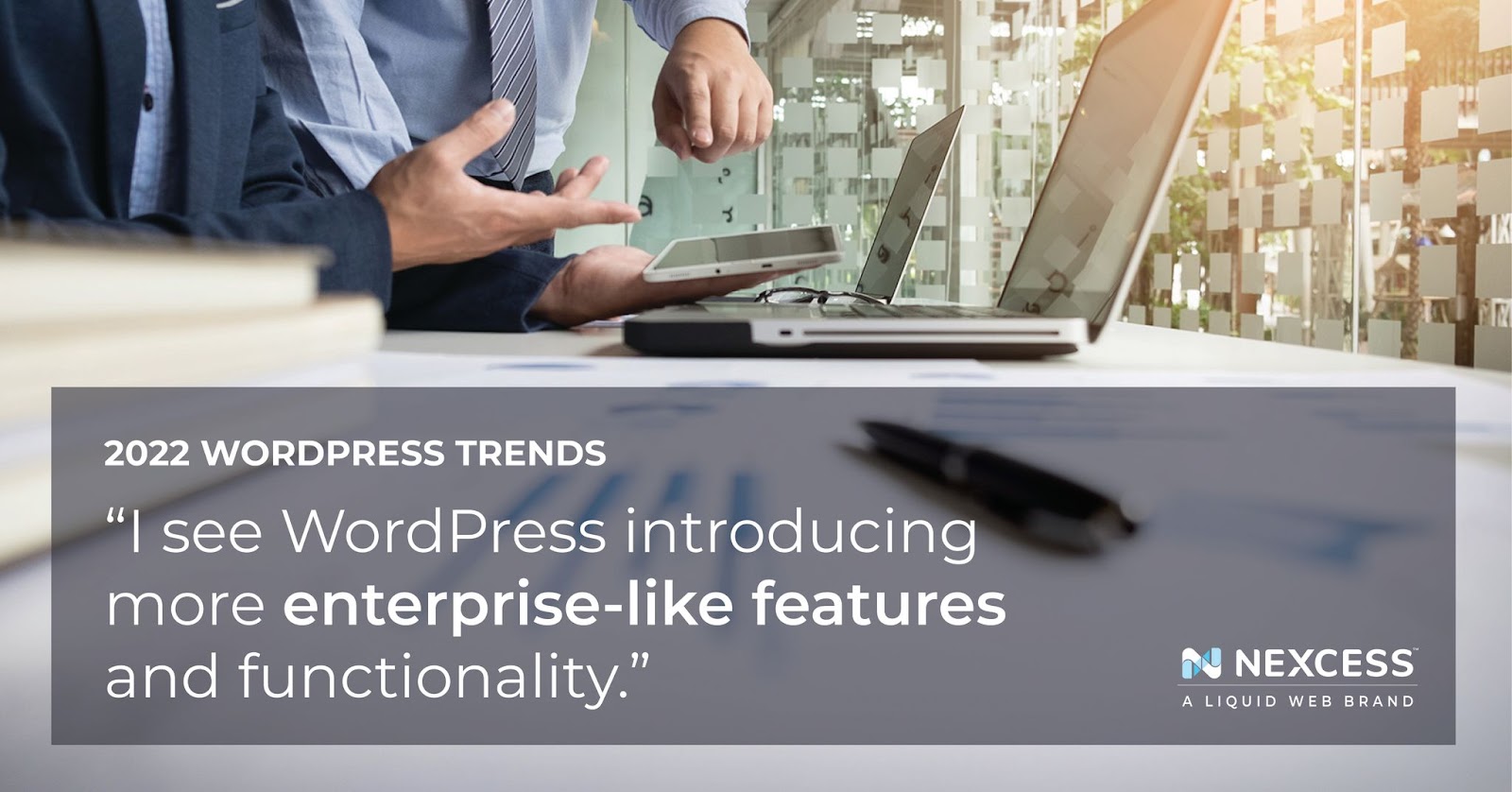22 WordPress Trends & Predictions for 2022
WordPress is almost 20 years old. And through its long and storied history, it has changed quite a bit, with each WordPress version introducing new and improved features. That’s not changing anytime soon.
With WordPress running over 40 percent of all websites on the internet today, the WordPress ecosystem is massive — and its future is looking bright.
To better understand where WordPress is headed, we spoke to WordPress experts and users from all over the world.
Without further ado, let’s take a look at some WordPress trends expected to emerge in 2022. Keep reading to learn about the future of WordPress.
22 Emerging WordPress Trends
Below are a few of the trends related to page building, tooling, and more.
-
No-Code & Low-Code Tools
“WordPress used to be ‘easy to get started’ a decade ago, but it no longer feels that way,” says Lesley Sim, co-founder of Newsletter Glue. Sim predicts an increase of no-code and low-code tools that will help newcomers get started with WordPress in 2022 and the coming years.
-
Drag & Drop Builders Are Here to Stay
“Drag and drop page builders are the easiest way to develop a whole website without the help of a developer. They are extremely easy to use and very affordable. A good example of this trend is the addition of the new WordPress Gutenberg block editor,” says Leandro Santorsola, entrepreneur, digital consultant, and WordPress user.
-
Automatic Updates for WordPress
“Automated theme and plugin updates were introduced by WordPress last year. While we generally recommend disabling this feature, we are intrigued by it,” says Darsh Somashekar, co-founder of drop.io and CEO of Solitaired.
“For enhanced functionality, many of our customers turn to third-party plugins and custom code. Without a close eye on WordPress theme and plugin updates, these customizations may become inoperable when the theme or plugin is updated. Updates, on the other hand, are critical for maintaining a secure, functional website. Automatic updates may be beneficial for website owners who maintain simple websites and frequently overlook plugin updates.”
At Hostdedi, we agree that automatic updates can be incredibly convenient and useful for WordPress users. It’s why automatic updates are supported in all of our fully managed WordPress and WooCommerce plans.
To prevent any problematic updates, we provide a visual comparison tool, which automatically creates a copy, updates your plugins, and gives you the ability to see what changes (if any) the plugin update made to your site before it goes into production.
-
Full Site Editing & Collaborative Editing
“We’re going to see a lot of activity in themes and page builders with full site editing (FSE) finally being merged into WordPress core,” says Tiffany Bridge, Product Manager of WordPress and Ecommerce at Hostdedi.
“The market has adapted to the block editor, but it will have more adapting to do as the WordPress editing experience continues to support the legacy Classic Editor, the Block Editor, and page builders in classic PHP-based themes. It will now also have to support block-based themes.”
Related reading: Beginner’s Guide to WordPress Performance Optimization >>
“Also related to the editing experience, a great deal of 2022 is going to be spent refining and enhancing the FSE experience, but I expect the core team’s attention to start turning toward the next phase, which is collaborative editing. I’d expect those features to start rolling out in the Gutenberg plugin as early as late 2022,” adds Bridge.
-
Reduced Learning Curve for WordPress Beginners
“I think the main trend you’ll see in the near future for WordPress is full site block editing. Using the Gutenberg editor, you’re already able to use blocks to easily redesign pages and posts. However, that functionality is going to be rolled out soon to all aspects of entire sites. This will cut down tremendously on the WordPress learning curve for newbies. However, the challenge here will be achieving optimal site speed while using these full site block editors, as they tend to slow sites down, which Google doesn’t like,” says Scott Winstead, founder of My Elearning World.
Related reading: Why is My WordPress Site So Slow?
-
Full Site Editing Knowledge Gaps
“As block-based themes and full site editing take over the WordPress landscape, they may create a knowledge gap among WordPress users,” predicts designer, developer, and strategist Daniel Schutzsmith.
“As WordPress core moves to have full site editing and block based themes, a learning gap and technical debt is emerging. Web developers and designers will be clamoring to understand the best way to work with these new technologies quickly,” says Schutzsmith. “Page builders will continue to be used in 2022, but there will be a much larger increase in new websites being built with Gutenberg and utilizing add-ons that make it more usable like Kadence Blocks.”
-
Fewer Third-Party Page Builders
“I’ve been using WordPress for over 11 years. Based on the latest big changes, I predict there’ll be less reliance on third-party page builders and design plugins for full site editing. The main reason behind this prediction is the roadmap released by WordPress regarding the Gutenberg project,” says Ankit Singla of Master Blogging.
“And, according to the roadmap, full site editing using only Gutenberg blocks is definitely on the table. Not to mention the rise of ‘block themes,’ which are designed to accommodate a wide range of customization options through Gutenberg.”
WordPress Design Trends
-
Video Headers
“Despite the fact that video headers and backgrounds have been around for a while, they have yet to take off on WordPress websites. Each year, WordPress releases a new default theme that is automatically available to all WordPress users. It incorporates several of the theme’s most powerful features, as well as a few custom elements that add interest,” says Brian Dean, founder of Backlinko and Co-Founder of Exploding Topics.
“The advent of video headers heralds the start of a new trend. We’ll have to keep an eye out for WordPress video headers, as the platform is rapidly gaining popularity worldwide.”
-
Parallax Effect
“Although parallax is not new, it continues to be a dominant design element in WordPress,” says Steve Scott, CTO at Spreadsheet Planet.
Parallax scrolling, also known as parallax effect, is the effect that occurs when you scroll down a page and the background content moves slower than the foreground content. It’s commonly used on one-page websites, where scrolling is an unavoidable part of the experience, and can be effective if the page contains broken sections of content.
“To implement the parallax effect in WordPress, you can utilize any of the popular parallax plugins or themes. Because this effect has a direct impact on the site’s accessibility and user experience, be careful when choosing a background image,” says Scott.
Related reading: 14 Modern Website Design Trends for 2022 >>
-
Dark Mode
“Dark mode is an imposing ultra-modern design that creates a vibrant impression while maintaining exceptional clarity and visibility. Additionally, dark mode helps the audience focus more on the content you’re showcasing because it alleviates eye strain,” says Marc Stitt, Chief Marketing Officer at GoFMX.
-
Chatbots Plugins
“Chatbots are extremely useful when used well. They can help you automate many repetitive tasks, such as answering the same question over and over again. It takes some time to get your business up to speed with this new technology. However, it is worth it for the cost-benefit ratio,” says Santorsola.
-
Microinteractions
“Microinteractions enable you to breathe life into your website. They create the illusion that the visitor is interacting with the content rather than simply reading it. These minor details contribute significantly to your website’s charm,” says Stitt.
“For instance, when the cursor hovers over an image, it will automatically pop up. Additionally, you can highlight the text and share it directly on social media.”
WordPress Theme Trends
-
Theme Marketplaces
“Theme marketplaces are a new trend affecting the WordPress ecosystem. Developers of theme customizers are now creating various customizer frameworks in order to enhance and provide a unique editing experience for WordPress users. Post-type templates can now be registered by developers.” — says Stephen Curry, CEO of CocoSign.
-
Themes Will Be Easier to Change
“In recent years, we’ve seen the growth of theme-based ecosystems, where your theme and related add-ons control much of your site experience. With full site editing and theme.json, WordPress themes will go back to defining the styling elements of a site. This will bring massive benefits to users who will be able to switch themes more easily as they won’t be locked in to a single theme that controls much of their site,” says Chris Lubkert, co-founder of Extendify.
-
Enhanced Customization Via Multipurpose Themes
“WordPress themes have impacted and styled the layout of your website since the platform’s inception. However, multi-purpose themes include customizations and integrated plugins in addition to their web design features — and their growing popularity makes them a top 2022 WordPress trend,” says Kathryn Smithson, CMO at PathSocial.
Related reading: The 7 Fastest WordPress Themes >>
“Additionally, there are numerous diverse and versatile multipurpose themes available, each with its own unique website templates and features. Whether an organization needs a fully functional company website, an online store, a business portfolio site, or simply a blogging platform, multipurpose themes optimized for those roles are available and ready to go,” says Smithson.
-
Mobile-Friendly Themes
“Mobile users have surpassed desktop users, and the gap is widening. As WordPress has shifted to mobile, the emphasis has shifted entirely to improving and enhancing the mobile user experience,” says Girish Redekar, co-founder of Sprinto.
“Due to the billions of people who own smartphones, we will see mobile-friendly WordPress themes as a leading WordPress trend in 2022.”
WordPress Trends for Developers
-
Supporting Modern Workflows for Devs
“I think that solutions and applications that enable modern workflows and approaches on WordPress will become increasingly sought after, and will also play an important role in making WordPress attractive to devs again, and continue to ensure the future of WordPress as a viable, relevant CMS,” says Miriam Schwab, CEO of Strattic.
“This includes better ways of managing version control and staging sites, headless implementations, embracing the Jamstack, and static site generation for WordPress.”
-
Loss of Some WordPress Devs
With the growth of easy to use solutions to create brochure websites — which include a homepage, about us, pricing, and contact us page — some developers may turn away from WordPress, predicts Patrick Rauland, Brand Manager at Paid Memberships Pro.
“The WordPress community will likely lose a lot of developers who build simple brochure websites. The developers and agencies who customize sites, who write plugins, who want to control every line of HTML and CSS will stick with WordPress. And the site owners who know how valuable it is to customize their site will also stick with WordPress.”
WordPress Trends: The WordPress Business
-
More Curated Offerings
“I see more focus on curated hosting and moving towards more of a SaaS offering. Pretty much exactly what GoDaddy and Pagely have announced, but across the entire space. There will also be a bigger focus on decoupled frontends, allowing for better scaling and performance enhancements,” says Jamie Madden, Founder of WC Vendors & License Server for WooCommerce.
-
Expansion Into Enterprise
“In terms of technology, I believe WordPress will grow significantly in the coming years. It appears to be tailored to personal bloggers, but I can see WordPress introducing more enterprise-like features and functionality,” says Curry.
“In the future, we’ll also see more synergies between WordPress.com and WordPress.org, as well as more premium plugin developers delivering top-tier products to the WordPress platform.”
-
Open Source Over Proprietary Solutions
“As an agency that works daily within WordPress, we’re always staying on top of what’s happening. Prediction: while website builders like Squarespace and Shopify work for many use cases, WordPress will continue to be one of the most popular and heavily used tools to power websites,” says John Rodgers, Principal & Co-Founder of The 215 Guys.
Chris Lubkert, Co-founder of Extendify, agrees and predicts that the WordPress core site creation experience will surpass that of other closed source platforms.
Related reading: WooCommerce vs Shopify: Key Differences and How to Choose >>
“Closed source platforms like Wix, Squarespace, and Shopify excel at providing a seamless way for users to quickly build a site. Historically, most WordPress users have had to find a legacy page builder or spend many hours piecing together different components to create their site. With full-site editing and continued enhancements to the Gutenberg block editor, it will be easier than ever for users to create a WordPress site in minutes using patterns, layouts, and full site kits,” says Lubkert.
“WordPress hosts will be able to leverage these enhancements to give their users a modern onboarding experience, while still maintaining the power and flexibility of an open source platform like WordPress.”
-
The Rise of Bundles
“Right now, it seems like users want to be able to ‘start a membership site’ or ‘start an ecommerce store’ or ‘start a newsletter and blog’ and click a button to do just that. They don’t want to find hosting, pick a theme, and figure out which plugins to use. As hosts continue to buy plugin and theme shops, I foresee them further simplifying their offerings and positioning them in this manner.”
“I think long-time WordPress pros won’t like this as they like the unbundled state and they’ve spent a decade learning which plugins work best for the kinds of sites they want to build. But I think it’ll be welcomed by people new to WordPress who ‘just want an online store’ and don’t even know or care what WooCommerce is,” says Sim.
Take 2022 By Storm With Fully Managed WordPress Hosting
Level up in 2022 with Hostdedi’ fully managed WordPress hosting plans. Our WordPress experts are ready to help you, whether you’re a beginner or advanced.
WordPress hosting by Hostdedi includes:
Advanced Features for Faster Sites
We include premium image compression, a built-in CDN, and advanced caching so your site loads fast every time.
Automatic Updates
All plans include worry-free automatic plugin updates with visual comparisons.
No Hidden Fees
You don’t have to worry about overage fees, traffic limits, or metered pageviews.
Free Migrations
Sit back and let us take care of it. Move your existing site to our hosting plans with our free migration service.
Premium Support and Security
Always-on security monitoring and 24/7/365 support from our WordPress experts ensure your site always runs smoothly.
Check out our fully managed WordPress hosting plans to get started today.









